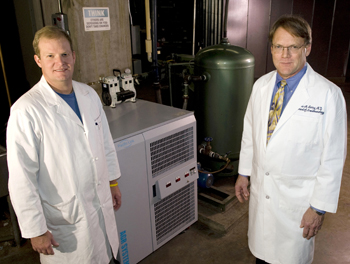New technology collects, recycles exhaled anesthetic
[Originally published by Vanderbilt Medical Center’s Office of News and Communication in The VUMC Reporter]
By Leslie Hast

A new technology, called the Dynamic Gas Scavenging System (DGSS), could have an impact on both the environment and health care economics.
The system, invented by James Berry, M.D., professor of Anesthesiology, along with Leland Lancaster, M.D, assistant in Anesthesiology, and Steve Morris, M.D., of the University of Mississippi Medical Center, collects air that contains exhaled anesthetic and condenses it, enabling it to be captured and recycled.
Because more than 500,000 gallons of anesthetic are released into the atmosphere in the United States each year, the potential savings from this technology, both financially and environmentally, are huge, Berry said.
“Vanderbilt spends $1 million a year on anesthetic. It is given to patients, then discarded, but it is $2,000 per gallon. My idea was that we can do better.”
The DGSS can recover 99 percent of anesthetics, without chemically altering them in the process.
Although Berry’s company, Anesthetic Gas Reclamation LLC, created the technology, Vanderbilt Medical Center has been instrumental in its development by providing a testing site in four operating rooms in The Vanderbilt Clinic.
According to Berry, VMC is the first in the country to do pilot testing with the DGSS system, and the first in the world to recycle anesthetics via condensation.
Berry formulated his idea for a recycling system in the 1980s when he first began studying anesthesia and noticed the pipe on the roof of the hospital where the anesthetic was released.
“I thought ‘What a waste. There’s got to be a better way,’” he recalled.
Most hospitals use a vacuum system to exhaust used anesthetic, and Berry knew that if he could tap into the system and cool the air containing anesthetic to -100 degrees, the vapor would turn back to a liquid and could be easily collected.
“We built models for two to three years in his basement,” Lancaster said, “but we were banging our heads wondering what we were missing.”
“The problem was we were pulling huge amounts of air but it had only a little bit of anesthetic,” Berry explained. “It was like trying to make rain in Arizona. I’d rather be in the Caribbean.”
Thus was born the DGSS, which activates the exhaust system only when the patient exhales and used anesthetic appears.
“Now there is a lot less air, which is richer in anesthetic, and it’s energy-saving because the exhaust pump can be much smaller,” Berry said.
The system is also universal, designed to work with any anesthesia machine.
One system costs $20,000 and can serve up to eight operating rooms. There are also energy savings, because the vacuum pump only runs 10 percent of the time, as opposed to 90 percent with the old system.
Additionally, the machine could generate revenue through carbon dioxide emissions credits. If hospitals don’t emit anesthetic (a potent greenhouse gas), they can sell those credits to others.
Berry said his next steps are to look at how to manufacture and commercialize the system. He also hopes to get FDA approval for a generic recycled anesthetic that could be sold for a significantly lower price.
“There are 6,000 hospitals in the U.S. I’d like to see at least half implement this technology,” Berry said. “We envision giving the machines away for free, just to get CO2 credits and the anesthetic. It’s highly efficient, it’s not emitting greenhouse gas into the environment, and it’s inexpensive. It’s not only good, but it’s practical.”

Leave a Response